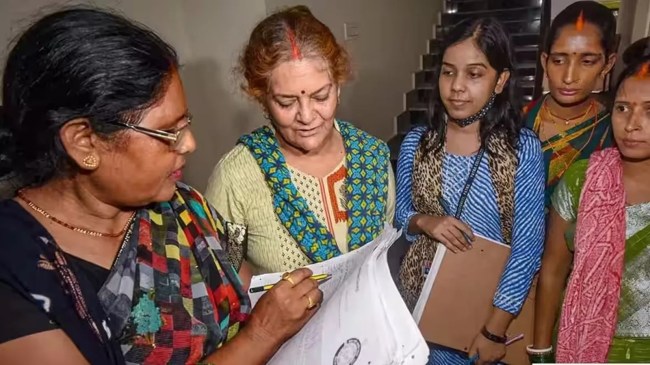Opinion Karnataka’s caste survey: It opens a door, but the direction we walk in is still uncertain
The survey is a test case for the future of Indian affirmative action. The challenge is not just statistical; it is moral. If we are serious about building a just society, then this must be treated not as a political liability but a constitutional opportunity
 Karnataka’s caste survey is not just a local development. (Source: File)
Karnataka’s caste survey is not just a local development. (Source: File) As a student of Political Science who has closely followed the unfolding caste Census/survey debates across India, I believe Karnataka’s 2025 caste survey marks a watershed moment in our quest for social justice. Having recently studied Telangana’s own bold experiments with caste data and affirmative action, I am both intrigued and cautious about what Karnataka’s new report signals — not just for the state, but for the nation at large.
The Karnataka caste survey, officially titled the “Socio-Economic and Educational Survey”, was conducted in 2015 but tabled only this month. It covers nearly 5.98 crore people, accounting for 94 per cent of the state’s population. What this report reveals is as politically explosive as it is analytically vital. Contrary to long-standing assumptions, dominant communities like the Lingayats and Vokkaligas — long considered the backbone of Karnataka’s power structure—constitute only 11.09 per cent and 10.31 per cent of the population respectively. In contrast, Other Backward Classes (OBCs) comprise a staggering 70 per cent, a figure that demands a serious rethinking of Karnataka’s reservation architecture. The report doesn’t merely record castes — it recalibrates the political and policy equations. For example, Muslims, categorised under II B in the OBC list, account for 12.58 per cent of the population. Scheduled Castes (SCs) make up 18.27 per cent, and Scheduled Tribes (STs) comprise 7.15 per cent. Meanwhile, the general category — including Brahmins and other upper castes — represents only 4.97 per cent. This dramatic skew calls into question whether our current quota system, still largely based on older assumptions and political balances, is truly reflective of Karnataka’s lived reality.
Drawing inspiration from Telangana, where the state raised OBC reservations to 42 per cent and introduced intra-SC sub-classifications, Karnataka’s Backward Classes Commission has now recommended a sweeping overhaul. OBC reservation is proposed to be increased from 32 per cent to 51 per cent, far exceeding the Supreme Court’s overall 50 per cent reservation ceiling set in the Indra Sawhney (1992) verdict and reaffirmed in the Maratha case (2021). The state is now confronted with a constitutional dilemma: How to reconcile data-driven equity with legal limits. In fact, Telangana attempted to overcome this hurdle by presenting its caste survey as a scientific justification for “extraordinary circumstances”. It emphasised not just population percentages, but socio-economic indicators like education levels, employment status, and political representation. Karnataka will have to follow a similar path — because the courts have made it clear that historical backwardness alone is not enough; contemporary disadvantages must be clearly demonstrated.
There are other parallels too. Telangana introduced a new categorisation within its SC list based on intra-group deprivation, backed by the August 2024 Supreme Court judgment overturning E V Chinnaiah (2004). This judgment now allows states to sub-categorise SCs for more equitable benefit distribution. Karnataka can use this precedent to introduce internal reforms within the SC/ST quotas as well, provided the Census data supports intra-group disparity. But while these legal pathways exist, the political landscape is far more volatile. In Telangana, dominant OBC and SC subgroups have resisted sub-classification, fearing dilution of their benefits. Karnataka is already seeing similar rumblings. Leaders from the Lingayat and Vokkaliga communities have raised serious objections to the survey’s methodology, alleging underrepresentation and calling for its rejection. Even within the ruling Congress, there is discord: There are many who championed this survey, while few others have expressed reservations, and warned of political fallout. This tension reveals a deeper irony. While caste Census data is collected in the name of justice, its implementation can fracture the very coalitions it aims to empower. Electoral calculations often override social considerations. In other words, the temptation to use this data for caste-targeted electoral mobilisation is real — and risky.
The larger question remains: Can we use caste data to uplift rather than divide? The Karnataka caste survey opens a door, but the direction we walk in is still uncertain. To transform this report into a tool of justice, the state must focus on implementation integrity. Data transparency is key. The methodologies used to collect, categorise, and analyse must be open to public and judicial scrutiny. Courts today demand more than political declarations — they want empirical rigour.
The report’s reservation recommendations are ambitious: II A (primarily Kurubas and other OBCs) quota to rise from 15 per cent to 22 per cent; II B (Muslims) from 4 per cent to 8 per cent; III A (Vokkaligas) to 7 per cent; III B (Lingayats) to 8 per cent; and I A (most backward classes) from 4 per cent to 6 per cent. ST reservations are suggested to increase from 7.5 per cent to 9.95 per cent. The cumulative total would push Karnataka’s reservation to 73.5 per cent, inviting inevitable legal scrutiny. But if backed by robust socio-economic data and presented under the exceptional circumstances clause, Karnataka may carve a constitutional pathway — just as Telangana is attempting to do. Ultimately, what this report compels us to confront is that India’s reservation discourse must evolve beyond static quotas and political appeasement. If caste still determines life chances — and the data says it does — then justice demands we count everyone and respond accordingly. But counting must lead to caring. Otherwise, we reduce the exercise to cynical electoral arithmetic, missing the transformative potential of what could be one of India’s most important policy shifts.
Karnataka’s caste survey is not just a local development. It is a test case for the future of Indian affirmative action — whether it will remain a 20th-century framework or evolve into a 21st-century tool of equity. The challenge is not just statistical; it is moral. If we are serious about building a just society, then this report must be treated not as a political liability but a constitutional opportunity.
The writer is professor and head, Department of Political Science, Maulana Azad National Urdu University, Hyderabad




